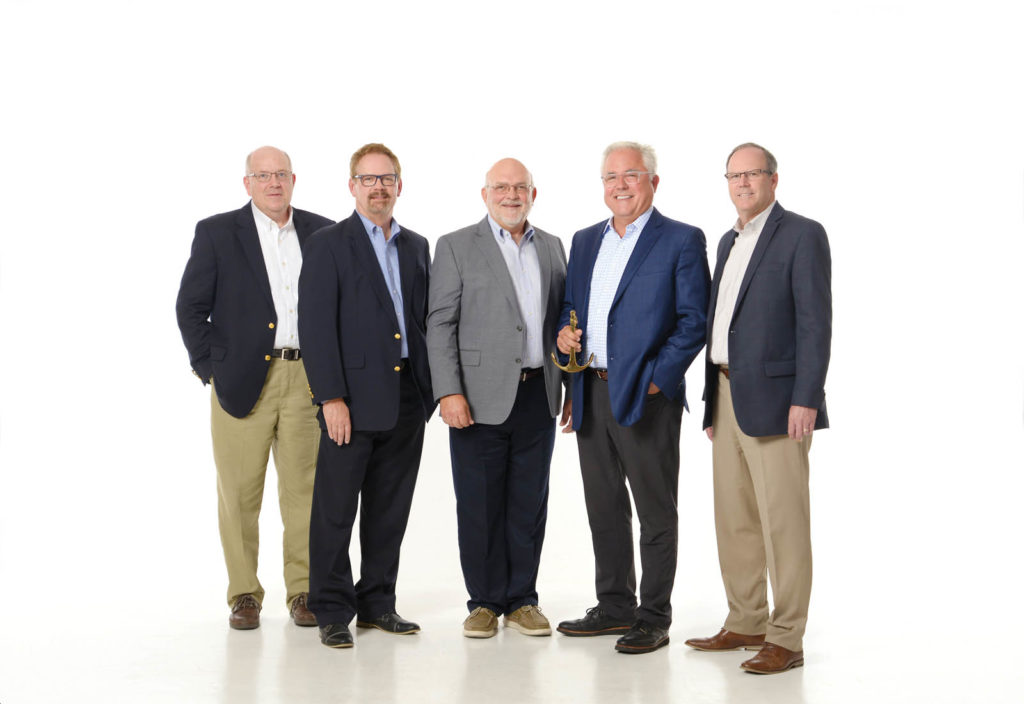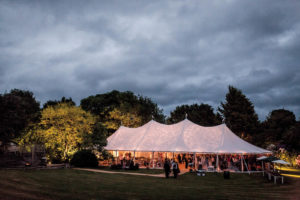Pete Mogavero leads the team at Anchor Industries to meet today’s market demands for quality, craftsmanship, speed and customization.
by Jill C. Lafferty
Anchor is 127 years old, and we have remarkable traditions here,” says Pete Mogavero, president of Anchor Industries Inc. “I’ve been here for 38 years; we’re a fifth-generation family business in stunning southern Indiana. We have deep roots. The family business is thriving. With all of that going for us, you’d think that we wouldn’t want to change much. However, our customers keep challenging us with new and creative ideas.”
Based in Evansville, Anchor Industries got its start as a riverboat supply house. Its founder, Louis A. Daus, responded to a demand at the time for waterproof covers by adding a canvas products line. Today, the company is known for its pioneering innovations in event tent technology, as well as its diverse array of fabric products, including awnings and canopies, shade structures, pool covers and specialty products ranging from fire shelters for wildland firefighters to tarps for baseball fields. Anchor employs more than 300 skilled workers and boasts more than 350,000 square feet of production capacity.

But while Anchor is a family business, Mogavero wasn’t born into it. Graduating with an MBA in finance from Indiana University, he went to work first at the National Bank of Detroit and then moved on to the Ford Motor Company.
“I came to the attention of executive management at Anchor when I married the boss’s daughter, Carrie Daus, in 1979,” Mogavero says. “Shortly after that I moved to Evansville and joined Anchor. John Daus, the CEO at the time, was the best boss I’ve ever had. He was a brilliant, caring and remarkable leader.”
Value through productivity
In its long history, two things haven’t changed for Anchor Industries, according to Mogavero: a high level of customer service and pride in craftsmanship. But today, those values have to be upheld in an environment that demands speed and customization.
“We pride ourselves in being the fastest to the market,” Mogavero says. “Lead times keep compressing. Quality and productivity continue to improve. Our people are proud craftsmen. That hasn’t changed. Our sales people have an extremely high level of customer intimacy. That hasn’t changed. We’re just doing all these things we used to do much, much faster. We can’t get this done without a strong team of VPs: Dave Conner, chief operating officer; Joey Ruffin, engineering; Bryan Peelman, production; and Bill Riat, credit.”
To meet the challenge of getting work done faster while maintaining quality, Anchor has introduced lean manufacturing principles, a systematic method of minimizing waste while maximizing productivity.
“We’ve been on a lean journey for 10 years,” Mogavero says. “Our customers are in an environment where they can’t say no. They’ve got to give their clients a ‘yes’ response, so we have to do the same. Our challenge is to do it faster. We have a strong bias for speed. And we’re not scared of challenges. In fact, I would be scared by the lack of challenges. Without them, we’re not doing our job for our customers.”
Over the years, Anchor has worked with consultants who help companies institute lean practices. Most recently Steve Brenneman, owner of The Aluminum Trailer Co., a trailer manufacturing company based in Nappanee, Ind., has been the company’s lean coach and mentor.
“He’s a gifted teacher and caring friend; he’s really ramped it up for us,” Mogavero says. “You can feel the excitement around here. It’s almost a ready-fire-aim mindset. ‘Get it done fast and do it with pride and perfection.’”
A recent development at Anchor that grew out of lean principles has changed Mogavero’s day-to-day role. “I’ve become the outside guy focusing on customers, and our chief financial officer, Dave Conner, was elevated to chief operating officer,” Mogavero says. “He’s in charge of lean and the inside operations. Dave’s been a remarkable disciple of lean business practices, and it shows. We’re paying a quarterly production gain share bonus to our production team members nearly every quarter now.”
A smooth ride
Asked about what a typical day is like for him, Mogavero’s first response is to quote J. Paul Getty: “Rise early, work hard, strike oil.” A more literal schedule starts with him arriving at Anchor every day by 7 a.m.
“I check my reports; go through hundreds of emails. What a ball and chain that is!” Mogavero says. “I like to get on Facebook periodically, find out who is having a birthday and send them a note. I get with our teams for early morning stand-up meetings where we discuss the state of the customers’ needs and the day’s sales quotes, customer questions and expectations, production hurdles, employee issues. Then I generally do my best to get out of the way to let each of the teams do their thing with pride, excellence, intelligence and passion.”
With the company’s open office environment, it’s easy to quickly get the pulse of the hot spots of the day, he continues. “We have very few departmental silos here,” he says. “The sales department sits directly next to engineering and R&D. Purchasing is right in the middle of it. Engineering is very close to production planning and the production department. It’s a finely tuned machine.”
Attending IFAI Tent Expo and Tent Conference annually, Mogavero values learning about Anchor’s competitors and seeing the company’s customers in a social setting.
“I really admire and respect our competitors: Jim Reyen, Eureka!; Chuck Miller and Alex Kouzmanoff, Aztec Tents; Michael Tharpe, Rainier Industries; Bryan Bolt, TopTec Event Tents; Fred Tracy, Fred’s Tents and Canopies Inc.; David Murray, Fiesta Tents Ltd.; Pat Moughan, Losberger De Boer; Gary Warner, Tentnology; Jeff Gepner, Liri Tent US; Robert Kraak, Shelter Structures America, and others. In my experience, they are all very gifted and fair-minded rivals whom I don’t mind sharing a drink with every now and then. They are a remarkable group of caring professionals who serve our industry very well.”
With 16 years at Anchor’s helm, Mogavero says that he’s still learning about leadership. “Over time I think I’m a bit more collaborative and fun, and yet I still do my best to keep the team on track. Frankly, when you deal with professionals, you agree on what needs to be done and then get out of the way. However, you can’t ignore when people don’t execute the plan in a timely, professional matter. The numbers mean something, and everyone has to understand their role in achieving our targets.”
Today, he considers himself to be both a passionate CEO (chief executive officer) and a CEEO (chief employee engagement officer).
“At the end of the day, Anchor is like a train that runs on a set of tracks,” he says. “The two rails we run on are employee satisfaction and customer satisfaction. When both are being cared for properly, the train runs smoothly. When one is out of whack, the train stops, and that’s not good for anybody. I’m most grateful for our customers. We’re nothing without them.”
Jill C. Lafferty is associate editor of Specialty Fabrics Review and senior editor of InTents.
 Anchor Industries’ reputation for innovation in the event tent industry stretches back to the 1960s, when it introduced the Fiesta Tent. The company sustained that reputation over the years with the additions of the Century® tension tent line and the Navi-Trac® frame tent system. But if you flip through the pages of any wedding magazine or search Instagram for wedding tents today, the Anchor tent you are most likely to see is the Aurora. “The Aurora is a stunningly beautiful, sheer-top, translucent tent,” Mogavero says. “It’s a round-end tent, it’s more traditional, it uses wood poles and aluminum center poles that have a wood finish, so it’s just really lovely.” In comparison, the Century line features a more opaque fabric and is more modern looking, while the Navi-Trac frame tent line is a favorite of tent rental companies because of its versatility and ease of installation. The Aurora, however, is a star in the wedding market. “It’s hard to put your finger on fashion. It’s like asking, ‘What is it about that dress that is appealing?’ With the Aurora, it’s different; it’s new but it’s traditional; it’s softer material; it’s just something that has a completely different feel than the standard Century tent,” he says.
Anchor Industries’ reputation for innovation in the event tent industry stretches back to the 1960s, when it introduced the Fiesta Tent. The company sustained that reputation over the years with the additions of the Century® tension tent line and the Navi-Trac® frame tent system. But if you flip through the pages of any wedding magazine or search Instagram for wedding tents today, the Anchor tent you are most likely to see is the Aurora. “The Aurora is a stunningly beautiful, sheer-top, translucent tent,” Mogavero says. “It’s a round-end tent, it’s more traditional, it uses wood poles and aluminum center poles that have a wood finish, so it’s just really lovely.” In comparison, the Century line features a more opaque fabric and is more modern looking, while the Navi-Trac frame tent line is a favorite of tent rental companies because of its versatility and ease of installation. The Aurora, however, is a star in the wedding market. “It’s hard to put your finger on fashion. It’s like asking, ‘What is it about that dress that is appealing?’ With the Aurora, it’s different; it’s new but it’s traditional; it’s softer material; it’s just something that has a completely different feel than the standard Century tent,” he says.
What are you most proud of? First off, I love this industry. We make beautiful spaces. We transform fabric, aluminum and glass—three basic materials—into stunningly beautiful spaces with the help of our gifted and visionary customers. I’m a sales guy deep down, and I try to position the company this way for success: I want prospects and customers to 1) Get to know us; 2) Like us; 3) Trust us. When all these things are happening, that’s the sweet spot for us. In the end, I’m most proud of our industry, our team of dedicated craftspeople and, most importantly, the customers we serve. They make our days fun and challenging. Finally, I am blessed to have my daughter, Christen, working with me. She graduated from Vanderbilt and spent her early career in Washington, D.C., working for the National Republican Congressional and Senatorial committees as well as the Senate Foreign Relations committee with Chairman Bob Corker. As you can imagine, she knows a lot about politics—a skill that will suit her well in this industry. She’s a quick study. Like driving, pretty soon those in the backseat may be the ones in the front.
 TEXTILES.ORG
TEXTILES.ORG


